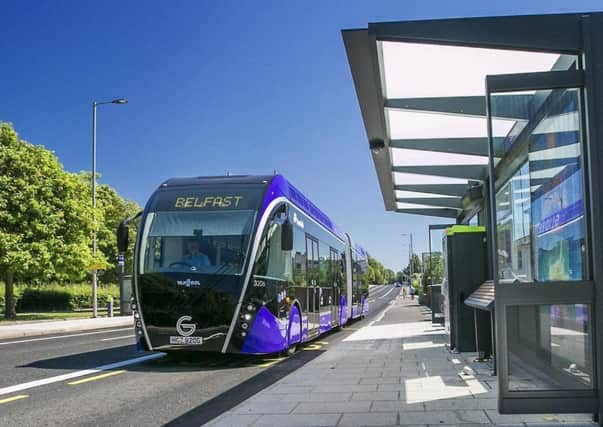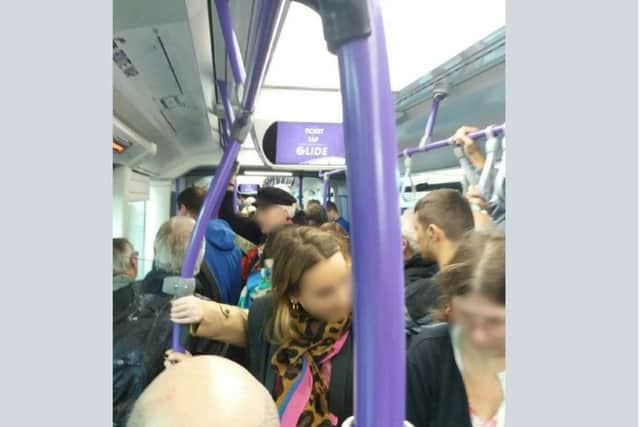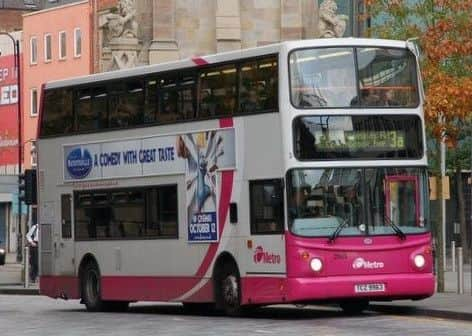Crammed Glider service in east Belfast has far, far fewer peak-time seats than the old buses did


The maximum number of seated places has been slashed from around 900 seats to around 400 between 8am and 9am, our analysis of the old and new vehicle capacities as compared against the old and new timetables shows.
Translink say that they always anticipated large amounts of standing, as is the case in all rapid transit systems, and which enables getting on and off easily and quickly.
Advertisement
Hide AdAdvertisement
Hide AdHowever, the journey time between the point in east Belfast at which standing becomes the peak-time norm, Knock, and the city centre is still taking 30 minutes ( sometimes more than that).


Gliders are often full and not even stopping when they reach Ballyhackamore, a few stops closer into Belfast.
In any event, the overall capacity in the new Gliders has also declined from 1,100 people in the peak hour double decker buses used previously to 1,000 in the new system.
The News Letter has worked this out by comparing the timetable of the old number 4 bus, which operated between Ballybeen/Dundonald and the city and the new Glider timetable.
Advertisement
Hide AdAdvertisement
Hide AdThe old number 4 route had 12 double deckers travelling at the height of the morning peak, between 8am and 9am (see panel, below, for timings from Knock, where all previous number 4 buses stopped, and the city centre).


There are now nine to 10 (explained below) Gliders that travel the route between Dundonald and Belfast city centre at that time in the morning rush hour.
The double decker buses had 74 seats and room for 18 people standing — a total capacity of 92 passengers.
The Glider can hold more people overall, 105, but far fewer people sitting — a total of only 46 seated (with a further 59 standing maximum).
Advertisement
Hide AdAdvertisement
Hide AdThat means that at the very height of the morning rush hour seat capacity has fallen radically from a potential 888 people seated to a mere 437.
The overall capacity, including people standing, has also fallen notably, albeit more modestly, in that busiest hour, from some 1,104 people overall to 997 people.
The figures help explain why the peak-time service has been beset by reports of people crammed into the vehicles.
There would have been a huge increase in standing in the vehicles even if passenger numbers had stayed the same as previously, but Translink claim that the route is attracting new passengers, which makes the overall drop in capacity even more stark.
Advertisement
Hide AdAdvertisement
Hide AdOur figures assume that that an average of 9.5 Gliders leave Dundonald between 8am and 9am —half of the 19 services that Translink say run 7am-9am (in fact their statement to us says fewer than that — it says eight run from 8am to 9am).
So our analysis gave them the more generous of the figures they supplied – ie, we assumed that half of those 19 services run between 8 and 9am.
Translink said: “We can confirm that there are 19 Glider departures from Dundonald Park &Ride to the city centre between 7am and 9am, (including 8 between 8am and 9am), then every 6-8 minutes from 9 to 5pm becoming less frequent until the last service from the east at 11.06pm. The current peak timetable schedule would be comparable to the previous Metro operation.
“We have a fleet of 30 vehicles and around 24 are required to operate at morning peak periods. Early indications suggest the new service has attracted more people on board the Glider, and over the last week we have operated two additional Glider vehicles on the eastern corridor providing additional capacity to ensure all halts are served along the route.”
Advertisement
Hide AdAdvertisement
Hide AdIt said the Glider has “many of the features of a tram” and caters for more standing “to enable greater capacity while the three sets of double doors, make it easier and faster for people to get off and on compared to a standard bus.”
• The News Letter has used the old double decker bus timetable as comparison, leaving from Knock, which is where standing is now the norm into Belfast on the Glider. We have also used Knock as the comparison point because an exact comparison is not possible because not all the previous number 4 buses originated at Dundonald Park and Ride.
The timetable which ended this July had 12 depatures from Knock, Monday to Friday, between 8am and 9am.
They were at: 0801 (4b), 0803 (4x), 0810 (4a), 0818 (4x), 0819 (4a), 0827 (4b), 0833 (4a), 0838 (4x), 0841 (4a) 0849 (4a), 0857 (4b), 0858 (4x).
Advertisement
Hide AdAdvertisement
Hide AdWhile the Translink used single decker buses on the route off peak, at peak times they invariably used double deckers.
Translink said in their statement to the News Letter yesterday: “This is a large and complex project for the city; the service is still bedding in as people become used to the changes the service brings.
“We also continue to make refinements each day to ensure we have the right capacity, at the right time, and at the right place.”
Advertisement
Hide AdAdvertisement
Hide AdThey added: “We have been very encouraged by the positive feedback overall and we would ask for patience as we work through any teething issues to build on these early results.”
Before the launch of the service, Translink told this newspaper more about its aims with the new service: “Glider vehicles are designed to carry more people than any of the existing Translink bus fleet. Gliders have capacity for 105 customers — 46 seated and 59 standing; and include a designated wheelchair space and access ramp; separate space for people with prams and a variety of seating types, including priority seating.”
Translink also said then: “ The Gliders provide seating for over 40% of their maximum capacity while trams typically only provide seating for around 30% of their maximum capacity.
“Based on average car occupancy commuting into Belfast, one full Glider vehicle could potentially replace 87 cars, helping to reduce congestion and improve air quality along the routes.”